DOI:
10.1039/C5RA01346A
(Paper)
RSC Adv., 2015,
5, 34206-34215
Degradation of cationic and anionic dyes in coagulation–flocculation process using bi-functionalized silica hybrid with aluminum-ferric as auxiliary agent
Received
23rd January 2015
, Accepted 7th April 2015
First published on 8th April 2015
Abstract
Cationic dye (methylene blue) and anionic dye (methyl orange) degradation in the coagulation process was demonstrated. The key material was a natural coagulant–laterite soil dominated by a silica component, while aluminum-ferric ions acted as an auxiliary agent in the degradation process. Charge neutralization, electrical double layer compression and sweeping flocculation were the mechanisms in the decolorization reaction. These results provided a new insight into effective dye degradation using a new class of natural coagulant–natural resources (laterite soil). The complex molecular structure of methylene blue and methyl orange was degraded into smaller hydrocarbon forms, accompanied by the formation of silsesquioxane. The silsesquioxane was the final product of degradation with promising flocculation and low volume sludge. Lastly, a comparison of the aluminum-based coagulant and a laterite soil natural coagulant shows a clear vision of the performance for both types of coagulant.
1. Introduction
The potential adverse effect of dyes and pigments on the environment is global nowadays. A wide range of industries such as the paper, leather, plastics, cosmetics, food, printing and pharmaceutical industries, apply dyes for their coloration processes, but by far the dominant industry utilized dye is the textile manufacturing industry. The dyeing process is the concept to link dye molecules covalently to fiber molecules, however incomplete exhaustion of dyes onto textile fibers has become a major problem.1 Subsequently, various pollutants such as remaining dyes, organic compounds and surfactants could be found in textile effluents.2 Proper treatment is required to ensure efficient removal of the pollutants before being discharged into the environment. This is because incompletely degraded products would create toxicological and ecotoxicological issues due to their toxic, non-biodegradable and mutagenic nature. For example, benzene can imperil human being nervous and vascular systems; phenol can affect aquatic system by hindering marine plants and organisms growth.3
Therefore, various methodologies, such as electro-peroxone, photocatalytic, advanced oxidation process, aerobic and anaerobic degradation using various microorganisms, coagulation,4–9 have been employed to study the dye degradation processes. Among them, coagulation is considered as one of the most practicable processes used in industrial wastewater treatment.10 Coagulation stage is an instantaneous process occurred when a coagulant is added into the colloidal dispersion wastewater. Subsequently, it leads to rapid breakage or rearrangement and aggregation of particles. Coagulation mechanisms can be accomplished by (1) electrical double layer compression, (2) adsorption and charge neutralization, (3) enmeshment in a precipitation, and (4) adsorption and interparticle bridging.11
The commonly used coagulants in industry are chemical-based coagulants, such as aluminum sulphate (alum), ferric chloride (FeCl3) and polyaluminum chloride (PACl). Application of these chemical substances creates several impacts, such as increase of metal concentration in water, voluminous toxic sludge produced and detrimental effects on human health. There is strong evidence linking aluminum-based coagulants to the development of Alzheimer's disease in human being.12 Due to the disadvantages of chemical coagulants, application of eco-friendly and natural coagulant phenomena was approached in order to substitute the chemical coagulants. Various coagulants had been identified from animal and plant origins such as chitosan,13 M. oleifera, tannin and cactus14 and okra extracted from okra seeds pod tips, plant stalk and root.15 Scientific results showed that requirement of alum could be reduced 50–90 % upon replacement of okra as primary coagulant and coagulant aid. Laterite soil which is naturally available on the earth is selected as natural coagulant since it contains elements of coagulation–flocculation functions. Laterite soil is not underlying in animal and plants origin, therefore a new class of natural coagulant is established which can be named as natural resources.
In this present work, a study of dye degradation using natural coagulant (laterite soil) was undertaken. Cationic dye (methylene blue) and anionic dye (methyl orange) were selected to analyze coagulation mechanisms of laterite soil with the aid of zeta potential measurements. Meanwhile, UV-Vis, GC-MS and FT-IR analysis were used to identify the degradation intermediates and products. Properties of degradation intermediates and products were essential to ensure zero potential hazardous substances were released. The results provided effectiveness comparison on laterite soil as natural coagulant with chemical-based coagulants.
2. Methodology
2.1 Dyes
Methylene blue (C16H18N3SCl; molecular weight 373.90 g-mol−1; absorption wavelength 664.00 nm) and methyl orange (C14H14N3NaO3S; molecular weight 327.33 g-mol−1; absorption wavelength 464.50 nm) were purchased from Sigma Aldrich. Their molecular structures are shown in Fig. 1. Stock solution of dyes was prepared by dissolving 1 g of dye with deionized water using a 1 L volumetric flask. 50 mg L−1 of dye solutions were prepared by diluting the stock solutions.
 |
| | Fig. 1 Chemical structures of dyes: (a) methylene blue; (b) methyl orange. | |
2.2 Characteristics of laterite soil
The morphology of laterite soil was analyzed using JEOL (Model JSM-6460LA) Analytical scanning electron microscope. Energy dispersive X-ray analysis (Model Oxford-50) was conducted for identifying the element contents in the laterite soil. Fig. 2 shows the morphology and topography of laterite soil. The characteristic of laterite soil was further analyzed by using X-ray fluorescence (XRF) to distinguish the exact element content percentage and the corresponding identified compounds are shown in Fig. 3. The major constituents of laterite soil are SiO2 (36.30%), Al2O3 (27.10%) and Fe2O3 (26.86%) as illustrated in the Fig. 2 and 3. The components in the laterite soil could act as coagulant and flocculant in the wastewater treatment.
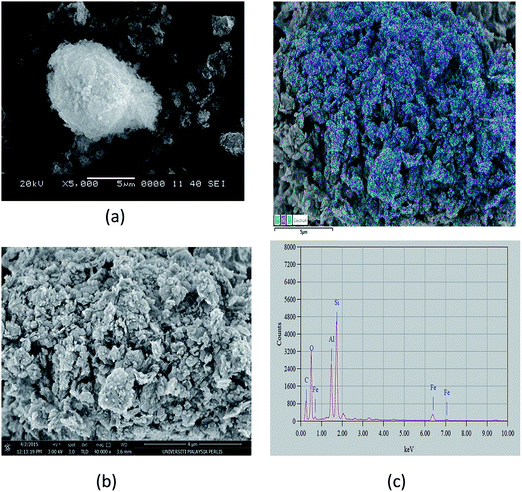 |
| | Fig. 2 (a) Morphology of laterite soil at low magnification 5000× (b) morphology of laterite soil at high magnification 40000× (c) topography element contents of laterite soil by using energy dispersive X-ray analysis. | |
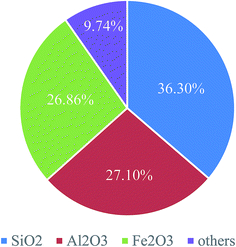 |
| | Fig. 3 Components contained of laterite soil. | |
2.3 Preparation of laterite soil
The laterite soil was collected from Bukit Merah, Perlis, Malaysia. The raw reddish laterite soil went through the following pretreatment: it was decolorized before being used as coagulant to treat synthetic dye wastewater. The laterite soil was mixed with ultrapure water and subsequently the mixtures were filtered with nylon cloth to remove the impurities. The laterite soil containing filtrate was collected and left to settle until double layers were observed. The aqueous phase was drained off and the laterite soil paste was dried under the sunlight. The procedure was repeated until the laterite soil was decolorized. The dried laterite soil was crushed into powder and sieved through 75 μm siever. The sieved laterite soil powder was mixed in ultrapure water and blended, followed by filtration to remove excessive fluid. Laterite soil paste collected on the filter paper was readily used as coagulant.
2.4 Coagulation experiments
The coagulation experiments on synthetic dye solutions were performed using Jar-Test apparatus (JLT6 VELP Scientifica). The optimum pH was obtained by fixing a coagulant dosage and varying the initial pH from 1 to 9, using dilute hydrochloric acid (HCl) or sodium hydroxide (NaOH) solution (0.01–0.1 M). The pH of each solution was measured by 827 pH lab (Methrohm). The mixtures of dye wastewater and laterite soil were stirred rapidly at 200 rpm for 2 minutes, then slowly at 100 rpm for 15 minutes. Subsequently, the mixtures were allowed to settle for 30 minutes. 20 mL of liquid was collected at 2 cm beneath the liquid in the settling beaker. The collected samples were filtered through 20–25 μm pore size Whatman filter papers and the filtrates were ready for analysis (Section 2.5). The identified optimum pH was used and the experiments were continued by varying the dosage of laterite soil coagulant. The procedures were continued as mentioned above.
2.5 Analysis
The color point (measure of dye concentration) of a dye solution was determined by using Hitachi u-2800 UV-Visible Spectrophotometer. The turbidity was determined by using Eutech TN 100 turbidity meter in Nephelometric Turbidity Unit (NTU). Zeta potential of a solution was measured by using Dispersion Technology – Acousto Phor Zeta Titration 310 method. After the optimum pH and laterite soil dosage have been determined to treat methylene blue and methyl orange, the sludge obtained at these optimum conditions were sent for sludge volume index (SVI) determination, Fourier transforms infrared spectrophotometry (FT-IR) and Thermogravimetric analysis (TGA) analyses. SVI analysis was carried out in accordance with the standard methods for the examination of water and wastewater.16 It is the volume in milliliters occupied by 1 g of a suspension after 30 min. settling. Equation used to calculate SVI is given below:| |
 | (1) |
| |
 | (2) |
where W2 is weight of filter disc with dried residue and W1 is weight of filter disc before use in milligram (mg).
FT-IR measurement on the sludge was carried out at room temperature on a Nicolet iS10 Smart OMNI-transmission FT-IR Spectrometer. The sludge produced after coagulation with laterite soil was collected and dried in the oven at 105 °C for 2 hours. Solidified sludge was dried and ground into powder subsequently, dispersed in a matrix to mix with potassium bromide (KBr). The mixture was transferred to a die that has a barrel diameter of 13 mm, subsequently the die was pressed to form a disc. The disc was removed carefully from the die and placed in the FT-IR sample holder. The content in the disc was ready for the 4000–450 cm−1 transmission spectrum analysis. For the mechanism elutriation, the intermediate compounds for methylene blue and methyl orange dyes removal were identified and analyzed with Gas Chromatography-Mass Spectrometry (GC-MS) (GC-2010 Plus, Shimadzu corporation, Japan) with BPX5 column.
3. Results and discussion
3.1 Effect of pH
Fig. 4 demonstrates the results of coagulation performance for methylene blue and methyl orange at different pH values. The results reveal that the dyes gave the highest performance at pH 2. Generally, when the solution shifted from acidic to alkaline condition, it led to decrease in color removal and increase in residual turbidity. When laterite soil is in contact with water, compounds in laterite soil: SiO2 (36.30%), Al2O3 (27.10%) and Fe2O3 (26.86%) would form Si(OH)4, Al(OH)3 and Fe(OH)3. SiO2 is able to act as a degradation catalyst as stated in the research by Li et al.17 Lau et al.18 reported that pH 2 is the point of zero charge (PZC) for laterite soil. At PZC, silica was present in [SiOH2+] and [SiO32−] forms, which were able to accept both cationic methylene blue and anionic methyl orange dyes. Simultaneously atmospheric oxides in laterite soil: Al2O3, Fe2O3, dissolved in strong acid to release Al3+ and Fe3+ ions which were then attracted to more stable anionic methyl orange dye molecules. Therefore, the optimal pH value for the maximal degradation of both dyes were pH 2 at which the dye colloids and coagulant had agglomerated and settled down.
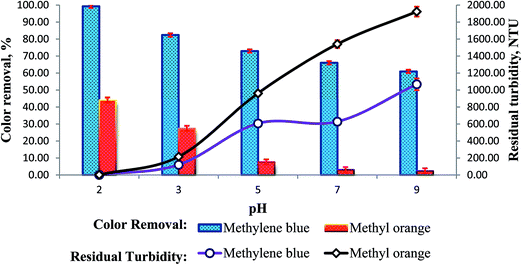 |
| | Fig. 4 Effect of pH on the color removal and residual turbidity of methylene blue and methyl orange. | |
In alkaline condition, the performance of laterite soil to treat the dyes decreased. This happened because addition of NaOH to adjust the pH of the system caused the silica to form a stable compound, Na2SiO3![[thin space (1/6-em)]](https://www.rsc.org/images/entities/char_2009.gif) 19 as shown in the equation below:
19 as shown in the equation below:
| | |
Si(OH)4 + 2NaOH ↔ Na2SiO3 + 3H2O
| (3) |
The removal of methylene blue could remain above 80% in alkaline condition because aluminum and ferric ions which react with OH− ions tends to form hydroxylaluminate and hydroxyl-ferric anions.20
| | |
Al(OH)3 + OH− ↔ Al(OH)4−
| (4) |
| | |
Fe(OH)3 + OH− ↔ Fe(OH)4−
| (5) |
However, the residual turbidity of methylene blue increased at a fast rate. This was attributed to the absence of silica which functioned as flocculant in the system. For the anionic methyl orange, as the pH increased to alkaline condition, the color removal decreased gradually and the residual turbidity increased rapidly. This was happening because aluminum and ferric in laterite soil were present as hydroxylaluminate and hydroxyl-ferric anions. Thus strong repulsive forces occurred between these anions and anionic methyl orange. Consequently, no interparticle bridging and aggregation of particles took place. Cationic and anionic dyes at different pH range did affect the performance of laterite soil in coagulation process, thus optimum pH should be taken into consideration to ensure effective charge neutralization in the system. Effective charge neutralization by adsorption of oppositely charged ions would enhance colloidal flocculation.21
3.2 Zeta potential
Fig. 5 shows the changes of zeta potential for laterite soil as a function of pH for the cationic and anionic dyes. Zeta potential measurements indicate the surface charges present on the laterite soil particles when it exists in aqueous suspension. Laterite soil would undergo acid-base amphoteric dissociation since it contains hydroxyls (OH−) on the surface (silanol group). A schematic diagram of the dissociation is shown in Fig. 6. The tendency for the hydroxyls to dissociate is strongly affected by pH. Addition of acid into dye solutions increased the concentration of protons in the solutions. Therefore SiO32− was formed in the diffuse layer. As the solution became more acidic, particularly at pH lower than 2, zeta potential readings became higher. This indicates that the degree of repulsion between similar charges dispersed in the diffuse layer, hence the colloids resisted to aggregate.22 As a result, zeta potential at acidic pH indicated positive values. On the other hand, at alkaline pH, OH− ions were adsorbed onto silica surfaces to form SiOH+2, resulting in negative zeta potential values. Hence, large diffuse electrical double layer took place.23 The PZC for the laterite soil with cationic and anionic dyes, both were detected at the pH value of 2.5 where silica colloids remained stationary in an electrical field. At this point, silica colloids aggregated and rearranged in order to balance the counter ions with dye particles. Meanwhile, zeta potential supported the effect of pH on the color removal and residual turbidity of methylene blue and methyl orange which have been discussed in Section 3.1.
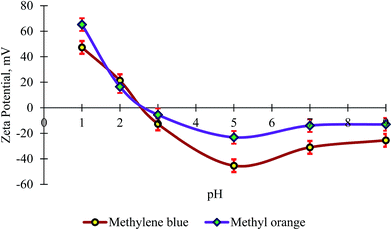 |
| | Fig. 5 Zeta potential measurements for laterite soil as a function of pH. | |
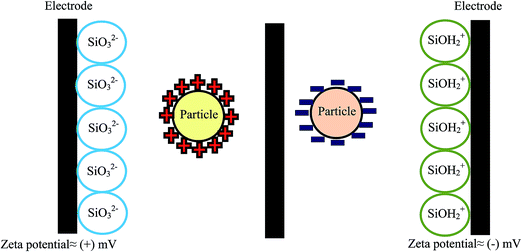 |
| | Fig. 6 Schematic diagram for acid-base dissociation of silanol group in laterite soil. | |
3.3 Degradation mechanism of cationic methylene blue dye
Fig. 7a depicts degradation pathway of methylene blue at pH 2. Methylene blue is a cationic dye favorable to bind with negatively charged surface.24 Therefore, the surface charge of silica which carries SiO32− destabilized methylene blue through charge neutralization by binding with the sulfate ion of methylene blue. When SiO32− was ion tied up with the sulfate ion, methylene blue structure became unstable and led to breakage at the weaker strength bond. As decolorization took place in a rapid manner, thiazine was prone to cleave in the initial stage of degradation which caused the disappearance of the absorbance peak at 664 nm under UV-Vis spectra (Fig. 8a). As verification, the FT-IR peaks shown in Fig. 9a from the range 1603 to 1394 cm−1, which represents aromatic ring structures in methylene blue, had almost vanished after coagulation. This indicates destruction of polyaromatic structure in methylene blue. Hence, N,N-dimethylaniline (C6H5N(CH3)2) (intermediate I) degradation intermediate released from the methylene blue structure was identified in GC-MS analysis (Fig. 10). Simultaneously, unstable anion molecule of RSiO3− (intermediate II) was formed. Subsequently, when two molecules of RSiO3− existed in the system, it tended to form siloxane molecule (R2SiO3). In general, one molecule of SiO32− was able to neutralize two molecules of cationic methylene blue by forming two molecules of N,N-dimethylaniline and one molecule of siloxane molecule (R2SiO3) (intermediate III). Instantly, the ![[double bond, length as m-dash]](https://www.rsc.org/images/entities/char_e001.gif) NH of the siloxane molecule tended to destabilize and detach, subsequently forming diazene. Diazene (HN
NH of the siloxane molecule tended to destabilize and detach, subsequently forming diazene. Diazene (HN![[double bond, length as m-dash]](https://www.rsc.org/images/entities/char_e001.gif) NH), also known as diimide, is a strong reducing agent for carbon–carbon double bond, (–C
NH), also known as diimide, is a strong reducing agent for carbon–carbon double bond, (–C![[double bond, length as m-dash]](https://www.rsc.org/images/entities/char_e001.gif) C–).25 Diazene scissored the –C
C–).25 Diazene scissored the –C![[double bond, length as m-dash]](https://www.rsc.org/images/entities/char_e001.gif) C– of benzene rings. When the benzene rings were opened, linear products of hydrocarbon, (CnHn) were created. Aromatic amine of intermediate I had undergone diazene reduction to form simple hydrocarbon product. This has been confirmed from the FT-IR spectra whereby peaks within 875 to 791 cm−1 entirely disappeared after coagulation. Lastly, the siloxane molecule with alkoxide group would undergo hydrolytic condensation reaction to form silsesquioxane as the final product of coagulation.26 A broad peak in FT-IR graph from range 1169 to 1000 cm−1 verifies the formation of silsesquioxane. The silsesquioxane characteristics of dimensionality, high symmetry, and nanometer size enhanced the formation of organosilicon compounds. The final product has built a strong sweeping flocculation in the system.
C– of benzene rings. When the benzene rings were opened, linear products of hydrocarbon, (CnHn) were created. Aromatic amine of intermediate I had undergone diazene reduction to form simple hydrocarbon product. This has been confirmed from the FT-IR spectra whereby peaks within 875 to 791 cm−1 entirely disappeared after coagulation. Lastly, the siloxane molecule with alkoxide group would undergo hydrolytic condensation reaction to form silsesquioxane as the final product of coagulation.26 A broad peak in FT-IR graph from range 1169 to 1000 cm−1 verifies the formation of silsesquioxane. The silsesquioxane characteristics of dimensionality, high symmetry, and nanometer size enhanced the formation of organosilicon compounds. The final product has built a strong sweeping flocculation in the system.
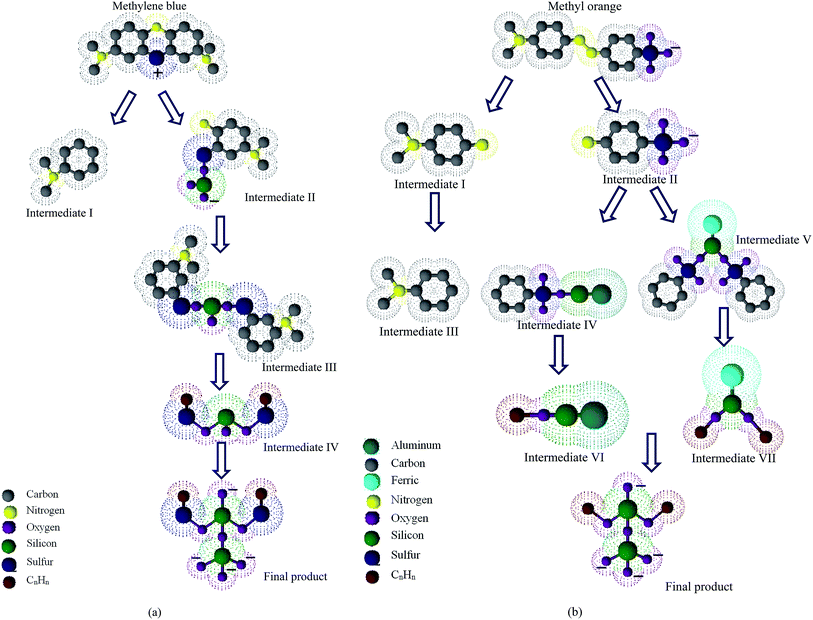 |
| | Fig. 7 Scheme with intermediates and products proposed for the degradation of (a) methylene blue; (b) methyl orange. | |
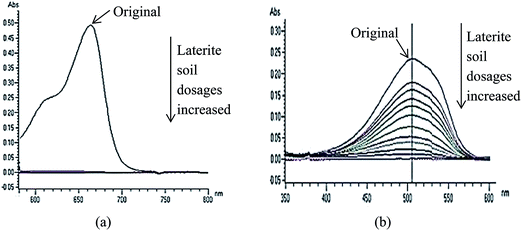 |
| | Fig. 8 UV-Vis absorption spectra of (a) methylene blue; (b) methyl orange as the function of coagulant dosage. | |
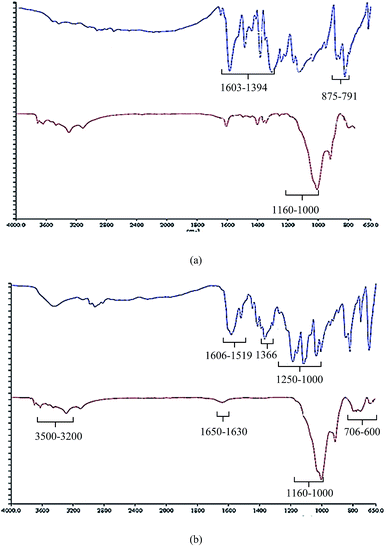 |
| | Fig. 9 FT-IR analysis before & after reaction for (a) methylene blue; (b) methyl orange. | |
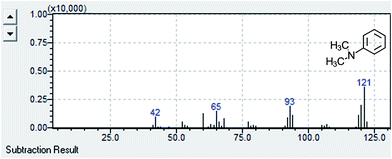 |
| | Fig. 10 GC-MS analysis for N,N-dimethylaniline (C6H5N(CH3)2). | |
3.4 Degradation mechanism of anionic methyl orange dye
When laterite soil was present in anionic methyl orange dye system at pH 2, the surface charge of silica carries cationic charge has changed the molecular structure of methyl orange. The decrease of the absorption spectra intensities of methyl orange is shown in Fig. 8b. Degradation rate of methyl orange is significantly lower than methylene blue due to the molecular structures of both dyes.27 As can be seen in this figure, the gradually disappearance of the characteristic band of methyl orange at 505.5 nm indicates that the first stage of degradation was the azo bond cleavage. The FT-IR band located at 1366 cm−1 which is assigned to azo bond of methyl orange has entirely vanished after reaction with laterite soil as shown in Fig. 9b. The breakage of azo bond led to formation of N,N-dimethyl-p-phenylenediamine ((CH3)2NC6H4NH2) (intermediate I) and p-amino-benzenesulfonic acid (C6H6NO3S) (intermediate II) as illustrated in Fig. 7b. The –NH2 from intermediates I and II proned to combine into diazene. Subsequently, the intermediate I structure reduced to N,N-dimethylaniline (C6H5N(CH3)2) (intermediate III). Meanwhile, intermediate II had been attacked by silica instantly accompanied by aluminum and ferric ions. This happened since methyl orange is a strongly bonded dye which was hard to degrade. Higher attraction force is required to enhance the dye destabilization. Subsequently, intermediates IV and V were formed. When sufficient diazene was present to scissor the benzene rings of the intermediates IV and V, linear hydrocarbon products, CnHnOn–Si![[triple bond, length as m-dash]](https://www.rsc.org/images/entities/char_e002.gif) Al (intermediate VI) and (CnHnOn)2–Si
Al (intermediate VI) and (CnHnOn)2–Si![[double bond, length as m-dash]](https://www.rsc.org/images/entities/char_e001.gif) Fe (intermediate VII) were formed. The FT-IR band within 1606 to 1519 cm−1 range represents aromatic rings in methyl orange which had been scissored after addition of laterite soil. The positions at 3500 to 3200 cm−1 and 1650 to 1630 cm−1 of FT-IR bands are evidence for the formation of intermediates VI and VII.28 From the proposed degradation pathway (Fig. 7b), Si
Fe (intermediate VII) were formed. The FT-IR band within 1606 to 1519 cm−1 range represents aromatic rings in methyl orange which had been scissored after addition of laterite soil. The positions at 3500 to 3200 cm−1 and 1650 to 1630 cm−1 of FT-IR bands are evidence for the formation of intermediates VI and VII.28 From the proposed degradation pathway (Fig. 7b), Si![[triple bond, length as m-dash]](https://www.rsc.org/images/entities/char_e002.gif) Al was able to bind with only one molecule of methyl orange, whereas Si
Al was able to bind with only one molecule of methyl orange, whereas Si![[double bond, length as m-dash]](https://www.rsc.org/images/entities/char_e001.gif) Fe was able to bind with two molecules of methyl orange. Silica ion is more favorable to tie with oxide ions. Hence after aluminum and ferric had destabilized the methyl orange structure, these metal ions would be detached from silica and formed metal hydroxides, Fe–OH and Al–OH as detected in FT-IR 706 to 600 cm−1 range. The free radical side of silica would attract oxide ions to form silsesquioxane. A broad peak in FT-IR graph from range 1160 to 1000 cm−1 is the verification of silsesquioxane formation. Similar to methylene blue, organosilicon structure was formed at the final degradation stage of methyl orange.
Fe was able to bind with two molecules of methyl orange. Silica ion is more favorable to tie with oxide ions. Hence after aluminum and ferric had destabilized the methyl orange structure, these metal ions would be detached from silica and formed metal hydroxides, Fe–OH and Al–OH as detected in FT-IR 706 to 600 cm−1 range. The free radical side of silica would attract oxide ions to form silsesquioxane. A broad peak in FT-IR graph from range 1160 to 1000 cm−1 is the verification of silsesquioxane formation. Similar to methylene blue, organosilicon structure was formed at the final degradation stage of methyl orange.
3.5 Sludge characteristics
Fig. 11 presents the sludge settling characteristics for methylene blue and methyl orange at the associated optimum dosages of laterite soil. The settling intervals were constructed until 200 min to observe the settling condition of sludge. During the initial 10 min of settling, the clarified water rose up whereas the sludge formed moved downwards by gravity force in a fast rate. For the proceeding settling, the settling rate began to decelerate as the sludge entered compression region. The volume of sludge continued to decrease until a time that it remained unchanged, specifically after 40 min of settling for both dyes. The treated dye solution zone and the settled sludge zone can be clearly differentiated. The maximum percentage of water recovery obtained for methylene blue and methyl orange are 98 and 74%, respectively. Furthermore, the sludge settling velocity of methylene blue (0.27 mL s−1) was faster compared to methyl orange (0.20 mL s−1). This confirm that methylene blue and methyl orange degradation led to the formation of high density organosilicon structure with good settling properties. Sludge volume index (SVI) for methylene blue and methyl orange are 18.69 and 26.77 mL g−1, respectively, which are in the best range according to the standard SVI test. Methylene blue has lower SVI compared to methyl orange. This is because methyl orange requires higher dosage of laterite soil for complete color removal and degradation. Lower extent of sludge yielded is preferable since industries can manage the sludge easily, thus preserving the environment.
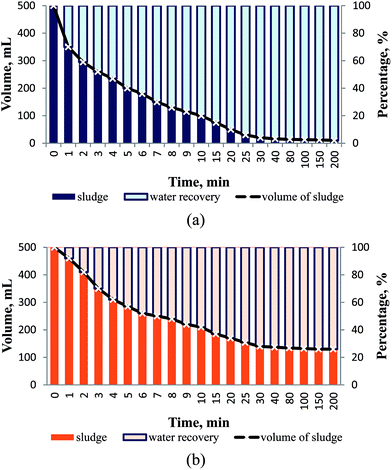 |
| | Fig. 11 Settling characteristics (a) methylene blue (b) methyl orange. | |
3.6 Sludge thermal degradability
Thermogravimetric analysis (TGA) profiles of sludge illustrated in Fig. 12 shows a weight loss of 1.43% in the temperature range of 100–200 °C. This phenomenon happened due to dehydration of sample and removal of volatile organic matter. An endothermic weight loss of 3.65% within the temperature range around 210–370 °C was observed. This endothermic weight loss was due to oxidation of organic substances containing C and H. As the energy of absorption was high, a partial oxidative decomposition of high concentration dye may be involved. When it reached the temperature of 398 °C, a sharp weight loss of 7.14% occurred. This weight loss contributed to further decomposition of the remaining dye molecules or dye interconnected with metal ions present in the sludge. The decomposition of metal coordinated ions continued until the formation of metal oxide.29 This behavior indicates that the sludge produced by laterite soil was thermally decomposable.
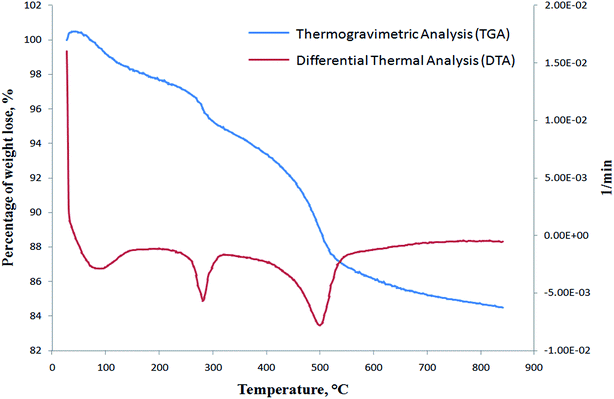 |
| | Fig. 12 TGA and DTA of sludge. | |
3.7 Comparison of the effectiveness of laterite soil as natural coagulant with chemical coagulant
A review on the effectiveness of aluminum-based coagulant, a chemical typed coagulant and a natural coagulant, laterite soil used are compared (Table 1). Patel and Vashi30 and Qiu et al.31 revealed that without the presence of coagulant aid, high dosage of aluminum-based coagulant was required to ensure high performance of removal (70![[thin space (1/6-em)]](https://www.rsc.org/images/entities/char_2009.gif) 000 mg L−1 to treat 74.50% of textile wastewater; 36
000 mg L−1 to treat 74.50% of textile wastewater; 36![[thin space (1/6-em)]](https://www.rsc.org/images/entities/char_2009.gif) 000 mg L−1 to treat 97.00% of printing wastewater). Only 23.00% removal was detected when 400 mg L−1 of alum was used to treat dyeing wastewater. Without the presence of color removal agent, alum could not effectively remove the colorant in the water; therefore color removal agent was essential to ensure high performance of alum in treating dye wastewater.32 With the presence of coagulant aids such as polyacrylamide based polymer (Cytec) and cethyltrimethyle-ammoniumbromide (CTAB), dosages of alum used had been successfully decreased. However the sludge yielded after coagulation was voluminous. Subsequently, higher expenses were required to deal with the voluminous toxic sludge yielded.35 On the other hand, photocatalytic process has been proven to be effective for dye degradation.36 Photocatalysis process is able to remove 80% of methylene blue at pH 9 using titanium dioxide (TiO2) nanofilm37 in 10 minutes. Besides, the photocatalysis process of methyl orange is reported at 81.3% at pH 6 using polyaniline modified zinc oxide (PANI/ZnO) in 2 hours.38 Contrast to chemical coagulant, laterite soil is able to treat cationic and anionic dye wastewater with a high performance at 99.61% and 92.11% without the presence of any coagulant aids and catalyst (photocatalysis). Moreover the sludge volume produced is very low and laid on the best range in the index of sludge volume. The massive impact of chemical coagulant to environment and human is the most significant. After coagulation process, the sludge formed by chemical coagulant are hard to degrade, thus tends to induce further environmental issues. Additionally, chemical coagulant especially aluminum-based coagulant had been proven for the development of Alzheimer's disease in human being. In the application of laterite soil as natural coagulant in coagulation, the sludge yielded is thermally decomposable and possessed zero hazards to environment and public.
000 mg L−1 to treat 97.00% of printing wastewater). Only 23.00% removal was detected when 400 mg L−1 of alum was used to treat dyeing wastewater. Without the presence of color removal agent, alum could not effectively remove the colorant in the water; therefore color removal agent was essential to ensure high performance of alum in treating dye wastewater.32 With the presence of coagulant aids such as polyacrylamide based polymer (Cytec) and cethyltrimethyle-ammoniumbromide (CTAB), dosages of alum used had been successfully decreased. However the sludge yielded after coagulation was voluminous. Subsequently, higher expenses were required to deal with the voluminous toxic sludge yielded.35 On the other hand, photocatalytic process has been proven to be effective for dye degradation.36 Photocatalysis process is able to remove 80% of methylene blue at pH 9 using titanium dioxide (TiO2) nanofilm37 in 10 minutes. Besides, the photocatalysis process of methyl orange is reported at 81.3% at pH 6 using polyaniline modified zinc oxide (PANI/ZnO) in 2 hours.38 Contrast to chemical coagulant, laterite soil is able to treat cationic and anionic dye wastewater with a high performance at 99.61% and 92.11% without the presence of any coagulant aids and catalyst (photocatalysis). Moreover the sludge volume produced is very low and laid on the best range in the index of sludge volume. The massive impact of chemical coagulant to environment and human is the most significant. After coagulation process, the sludge formed by chemical coagulant are hard to degrade, thus tends to induce further environmental issues. Additionally, chemical coagulant especially aluminum-based coagulant had been proven for the development of Alzheimer's disease in human being. In the application of laterite soil as natural coagulant in coagulation, the sludge yielded is thermally decomposable and possessed zero hazards to environment and public.
Table 1 Comparison of effectiveness of laterite soil as natural coagulant with chemical coagulant
| Type of wastewater |
Aluminum-based coagulant |
Laterite Soil |
| Textile wastewater |
Printing wastewater |
Dyeing wastewater |
Disperse and reactive dyes wastewater |
Remazol red RB textile dye (25 ppm) |
50 mg L−1 |
| Methylene blue |
Methyl orange |
Acid orange 7 |
| Flocculant |
Without |
Without |
Without |
Cytec |
CTAB |
Without |
Without |
Without |
| pH |
5.70–6.50 |
7.01 |
8.00 |
5.30 |
10.05 |
2.00 |
2.00 |
2.00 |
| Dosage, mg L−1 |
70![[thin space (1/6-em)]](https://www.rsc.org/images/entities/char_2009.gif) 000 000 |
36![[thin space (1/6-em)]](https://www.rsc.org/images/entities/char_2009.gif) 000 000 |
400 |
200 |
100 |
2500 |
15![[thin space (1/6-em)]](https://www.rsc.org/images/entities/char_2009.gif) 000 000 |
10![[thin space (1/6-em)]](https://www.rsc.org/images/entities/char_2009.gif) 000 000 |
| Removal (%) |
74.50 |
97.00 |
23.00 |
94.00 |
100.00 |
99.61 |
92.11 |
98.47 |
| SVI range |
— |
55.81 |
Large quantities |
83.50 |
140.00 (voluminous) |
18.69 |
26.77 |
21.70 |
| (Best range) |
| Effect |
Aluminum-based coagulants tend to develop Alzheimer's disease in human being |
No possible hazards may present due to its naturalism. |
| References |
30 |
31 |
33 |
34 |
19 |
This study |
This study |
18 |
4. Conclusion
A new concept for dye degradation by using laterite soil was demonstrated. Laterite soil was a newly found natural coagulant from natural resources which contained silica hybrid with aluminum-ferric as auxiliary agents. Successful cationic dye (methylene blue) and anionic dye (methyl orange) degradation was accomplished through charge neutralization, electrical double layer compression and sweeping flocculation mechanisms. Laterite soil was capable to degrade dye molecular structure into simple hydrocarbon structure with the formation of silsesquioxane as final product. The silsesquioxane products had promising flocculation effect and low sludge production through formation of high density and compact floc.
Abbreviations and symbols
| Al2O3 | Aluminum oxide |
| Al(OH)3 | Aluminum hydroxide |
| Al(OH)4− | Hydroxylaluminate anion |
| Fe2O3 | Ferric oxide |
| Fe(OH)3 | Ferric hydroxide |
| Fe(OH)4− | Hydroxylferric anion |
| HCl | Hydrochloric acid |
| NaOH | Sodium hydroxide |
| PZC | Point of zero charge |
| SiO2 | Silicon dioxide |
| SVI | Sludge volume index |
Acknowledgements
The authors would like to express their thanks for the support by Universiti Sains Malaysia (USM) and Universiti Malaysia Perlis (UniMAP).
References
- R. A. Pereira, M. F. R. Pereira, M. M. Alves and L. Pereira, Appl. Catal., B, 2014, 144, 713–720 CrossRef CAS PubMed.
- B. H. Tan, T. T. Teng and A. K. Mohd Omar, Water Res., 2000, 34, 597–601 CrossRef CAS.
- J. Li, D. Wang, D. Yu, P. Zhang and Y. Li, Chem. Eng. J., 2014, 240, 82–90 CrossRef CAS PubMed.
- Y. Wang, Water Res., 2000, 34, 990–994 CrossRef CAS.
- Y. S. Wong, T. T. Teng, S. A. Ong, N. Morad and M. Rafatullah, RSC Adv., 2014, 4, 64659–64667 RSC.
- X. Chen and S. S. Mao, Chem. Rev., 2007, 107, 2891–2959 CrossRef CAS PubMed.
- V. K. Saharan, A. B. Pandit, P. S. Satish Kumar and S. Anandan, Ind. Eng. Chem. Res., 2012, 51, 1981–1989 CrossRef CAS.
- B. Bakheet, S. Yuan, Z. Li, H. Wang, J. Zuo, S. Komarneni and Y. Wang, Water Res., 2013, 47, 6234–6243 CrossRef CAS PubMed.
- V. Murali, S. A. Ong, L. N. Ho and Y. S. Wong, Bioresour. Technol., 2013, 143, 104–111 CrossRef CAS PubMed.
- F. Sher, A. Malik and H. Liu, J. Environ. Chem. Eng., 2013, 4, 684–689 CrossRef PubMed.
- J. Bratby, Coagulation and Flocculation in Water and Wastewater Treatment, McGraw-Hill, New York, 2nd edn, 2006 Search PubMed.
- T. P. Flaten, Brain Res. Bull., 2001, 55, 187–196 CrossRef CAS.
- F. Renault, B. Sancey, P.-M. Badot and G. Crini, Eur. Polym. J., 2009, 45, 1337–1348 CrossRef CAS PubMed.
- C. Y. Yin, Process Biochem., 2010, 45, 1437–1444 CrossRef CAS PubMed.
- A. Al-Samawi and E. M. Shokralla, J. Environ. Sci. Health, Part A: Toxic/Hazard. Subst. Environ. Eng., 1996, 31, 1881–1897 CrossRef.
- APHA, AWWA and WEF, Standard Methods for the Examination of Water and Wastewater, American Public Health Association, Washington, D.C, 21st edn, 2005 Search PubMed.
- H. Li, X. He, Z. Kang, H. Huang, Y. Liu, J. Liu, S. Lian, C. H. A. Tsang, X. Yang and S.-T. Lee, Angew. Chem., 2010, 49, 4430–4434 CrossRef CAS PubMed.
- Y. Y. Lau, Y. S. Wong, T. T. Teng, M. Norhashimah, M. Rafatullah and S. A. Ong, Chem. Eng. J., 2014, 246, 383–390 CrossRef CAS PubMed.
- L. Q. Zhu, Y. H. Li and W. P. Li, Surf. Coat. Technol., 2008, 202, 5853–5857 CrossRef CAS PubMed.
- A. Gurses, M. Yalcin and C. Dogar, Water, Air, Soil Pollut., 2003, 146, 297–318 CrossRef.
- Y. Adachi, Y. Kusaka and A. Kobayashi, Colloids Surf., A, 2011, 376, 9–13 CrossRef CAS PubMed.
- T. Takeshima, L. Sun, Y. Wang, Y. Yamada, N. Nishi, T. Yonezawa and B. Fugetsu, Polym. J., 2014, 46, 36–41 CrossRef CAS.
- Y. Yukselen and A. Kaya, Environ. Earth Sci., 2011, 62, 697–705 CrossRef.
- E. Saliby, L. Erdei, J.-H. Lim and H. K. Shon, Water Res., 2013, 47, 4115–4125 CrossRef PubMed.
- D. J. Pasto and R. T. Taylor, Organic Reactions: Reduction with Diimide, John Wiley & Sons, Inc., New York, 2004 Search PubMed.
- E. Ayandele, B. Sarkar and P. Alexandridis, Nanomaterials, 2012, 2, 445–475 CrossRef CAS PubMed.
- S. A. Ong, L. N. Ho and Y. S. Wong, Desalin. Water Treat., 2014, 54(2), 557–561 CrossRef.
- T. Sun, C. H. Sun, G. L. Zhu, X. J. Miao, C. C. Wu, S. B. Lv and W. J. Li, Desalination, 2011, 268, 270–275 CrossRef CAS PubMed.
- P. Kumar, B. Prasad, I. M. Mishra and S. Chand, J. Hazard. Mater., 2008, 153, 635–645 CrossRef CAS PubMed.
- H. Patel and R. T. Vashi, J. Chem., 2010, 7, 1468–1476 CAS.
- Z. M. Qiu, W. T. Jiang and Z. J. He, J. Hazard. Mater., 2009, 166, 740–745 CrossRef CAS PubMed.
- J. Mo, J. Hwang, J. Jegal and J. Kim, Dyes Pigm., 2007, 72, 240–245 CrossRef CAS PubMed.
- N. Azbar, T. Yonar and K. Kestioglu, Chemosphere, 2004, 55, 35–43 CrossRef CAS PubMed.
- F. El-Gohary and A. Tawfik, Desalination, 2009, 249, 1159–1164 CrossRef CAS PubMed.
- S. Niyomkarn, T. Puangpetch and S. Chavadej, Mater. Sci. Semicond. Process., 2014, 25, 112–122 CrossRef CAS PubMed.
- X. Li, K. Wu, C. Dong, S. Xia, Y. Ye and X. Wei, Mater. Lett., 2014, 130, 97–100 CrossRef CAS PubMed.
- L. Rizzo, J. Koch, V. Belgiorno and M. A. Anderson, Desalination, 2007, 211, 1–9 CrossRef CAS PubMed.
- W. Melaku, O. P. Yadav and T. Kebede, Sci., Technol. Arts Res. J., 2014, 3, 93–102 CrossRef.
|
| This journal is © The Royal Society of Chemistry 2015 |
Click here to see how this site uses Cookies. View our privacy policy here. 


![[thin space (1/6-em)]](https://www.rsc.org/images/entities/char_2009.gif) 19 as shown in the equation below:
19 as shown in the equation below:![[double bond, length as m-dash]](https://www.rsc.org/images/entities/char_e001.gif) NH of the siloxane molecule tended to destabilize and detach, subsequently forming diazene. Diazene (HN
NH of the siloxane molecule tended to destabilize and detach, subsequently forming diazene. Diazene (HN![[double bond, length as m-dash]](https://www.rsc.org/images/entities/char_e001.gif) NH), also known as diimide, is a strong reducing agent for carbon–carbon double bond, (–C
NH), also known as diimide, is a strong reducing agent for carbon–carbon double bond, (–C![[double bond, length as m-dash]](https://www.rsc.org/images/entities/char_e001.gif) C–).25 Diazene scissored the –C
C–).25 Diazene scissored the –C![[double bond, length as m-dash]](https://www.rsc.org/images/entities/char_e001.gif) C– of benzene rings. When the benzene rings were opened, linear products of hydrocarbon, (CnHn) were created. Aromatic amine of intermediate I had undergone diazene reduction to form simple hydrocarbon product. This has been confirmed from the FT-IR spectra whereby peaks within 875 to 791 cm−1 entirely disappeared after coagulation. Lastly, the siloxane molecule with alkoxide group would undergo hydrolytic condensation reaction to form silsesquioxane as the final product of coagulation.26 A broad peak in FT-IR graph from range 1169 to 1000 cm−1 verifies the formation of silsesquioxane. The silsesquioxane characteristics of dimensionality, high symmetry, and nanometer size enhanced the formation of organosilicon compounds. The final product has built a strong sweeping flocculation in the system.
C– of benzene rings. When the benzene rings were opened, linear products of hydrocarbon, (CnHn) were created. Aromatic amine of intermediate I had undergone diazene reduction to form simple hydrocarbon product. This has been confirmed from the FT-IR spectra whereby peaks within 875 to 791 cm−1 entirely disappeared after coagulation. Lastly, the siloxane molecule with alkoxide group would undergo hydrolytic condensation reaction to form silsesquioxane as the final product of coagulation.26 A broad peak in FT-IR graph from range 1169 to 1000 cm−1 verifies the formation of silsesquioxane. The silsesquioxane characteristics of dimensionality, high symmetry, and nanometer size enhanced the formation of organosilicon compounds. The final product has built a strong sweeping flocculation in the system.


![[triple bond, length as m-dash]](https://www.rsc.org/images/entities/char_e002.gif) Al (intermediate VI) and (CnHnOn)2–Si
Al (intermediate VI) and (CnHnOn)2–Si![[double bond, length as m-dash]](https://www.rsc.org/images/entities/char_e001.gif) Fe (intermediate VII) were formed. The FT-IR band within 1606 to 1519 cm−1 range represents aromatic rings in methyl orange which had been scissored after addition of laterite soil. The positions at 3500 to 3200 cm−1 and 1650 to 1630 cm−1 of FT-IR bands are evidence for the formation of intermediates VI and VII.28 From the proposed degradation pathway (Fig. 7b), Si
Fe (intermediate VII) were formed. The FT-IR band within 1606 to 1519 cm−1 range represents aromatic rings in methyl orange which had been scissored after addition of laterite soil. The positions at 3500 to 3200 cm−1 and 1650 to 1630 cm−1 of FT-IR bands are evidence for the formation of intermediates VI and VII.28 From the proposed degradation pathway (Fig. 7b), Si![[triple bond, length as m-dash]](https://www.rsc.org/images/entities/char_e002.gif) Al was able to bind with only one molecule of methyl orange, whereas Si
Al was able to bind with only one molecule of methyl orange, whereas Si![[double bond, length as m-dash]](https://www.rsc.org/images/entities/char_e001.gif) Fe was able to bind with two molecules of methyl orange. Silica ion is more favorable to tie with oxide ions. Hence after aluminum and ferric had destabilized the methyl orange structure, these metal ions would be detached from silica and formed metal hydroxides, Fe–OH and Al–OH as detected in FT-IR 706 to 600 cm−1 range. The free radical side of silica would attract oxide ions to form silsesquioxane. A broad peak in FT-IR graph from range 1160 to 1000 cm−1 is the verification of silsesquioxane formation. Similar to methylene blue, organosilicon structure was formed at the final degradation stage of methyl orange.
Fe was able to bind with two molecules of methyl orange. Silica ion is more favorable to tie with oxide ions. Hence after aluminum and ferric had destabilized the methyl orange structure, these metal ions would be detached from silica and formed metal hydroxides, Fe–OH and Al–OH as detected in FT-IR 706 to 600 cm−1 range. The free radical side of silica would attract oxide ions to form silsesquioxane. A broad peak in FT-IR graph from range 1160 to 1000 cm−1 is the verification of silsesquioxane formation. Similar to methylene blue, organosilicon structure was formed at the final degradation stage of methyl orange.
![[thin space (1/6-em)]](https://www.rsc.org/images/entities/char_2009.gif) 000 mg L−1 to treat 74.50% of textile wastewater; 36
000 mg L−1 to treat 74.50% of textile wastewater; 36![[thin space (1/6-em)]](https://www.rsc.org/images/entities/char_2009.gif) 000 mg L−1 to treat 97.00% of printing wastewater). Only 23.00% removal was detected when 400 mg L−1 of alum was used to treat dyeing wastewater. Without the presence of color removal agent, alum could not effectively remove the colorant in the water; therefore color removal agent was essential to ensure high performance of alum in treating dye wastewater.32 With the presence of coagulant aids such as polyacrylamide based polymer (Cytec) and cethyltrimethyle-ammoniumbromide (CTAB), dosages of alum used had been successfully decreased. However the sludge yielded after coagulation was voluminous. Subsequently, higher expenses were required to deal with the voluminous toxic sludge yielded.35 On the other hand, photocatalytic process has been proven to be effective for dye degradation.36 Photocatalysis process is able to remove 80% of methylene blue at pH 9 using titanium dioxide (TiO2) nanofilm37 in 10 minutes. Besides, the photocatalysis process of methyl orange is reported at 81.3% at pH 6 using polyaniline modified zinc oxide (PANI/ZnO) in 2 hours.38 Contrast to chemical coagulant, laterite soil is able to treat cationic and anionic dye wastewater with a high performance at 99.61% and 92.11% without the presence of any coagulant aids and catalyst (photocatalysis). Moreover the sludge volume produced is very low and laid on the best range in the index of sludge volume. The massive impact of chemical coagulant to environment and human is the most significant. After coagulation process, the sludge formed by chemical coagulant are hard to degrade, thus tends to induce further environmental issues. Additionally, chemical coagulant especially aluminum-based coagulant had been proven for the development of Alzheimer's disease in human being. In the application of laterite soil as natural coagulant in coagulation, the sludge yielded is thermally decomposable and possessed zero hazards to environment and public.
000 mg L−1 to treat 97.00% of printing wastewater). Only 23.00% removal was detected when 400 mg L−1 of alum was used to treat dyeing wastewater. Without the presence of color removal agent, alum could not effectively remove the colorant in the water; therefore color removal agent was essential to ensure high performance of alum in treating dye wastewater.32 With the presence of coagulant aids such as polyacrylamide based polymer (Cytec) and cethyltrimethyle-ammoniumbromide (CTAB), dosages of alum used had been successfully decreased. However the sludge yielded after coagulation was voluminous. Subsequently, higher expenses were required to deal with the voluminous toxic sludge yielded.35 On the other hand, photocatalytic process has been proven to be effective for dye degradation.36 Photocatalysis process is able to remove 80% of methylene blue at pH 9 using titanium dioxide (TiO2) nanofilm37 in 10 minutes. Besides, the photocatalysis process of methyl orange is reported at 81.3% at pH 6 using polyaniline modified zinc oxide (PANI/ZnO) in 2 hours.38 Contrast to chemical coagulant, laterite soil is able to treat cationic and anionic dye wastewater with a high performance at 99.61% and 92.11% without the presence of any coagulant aids and catalyst (photocatalysis). Moreover the sludge volume produced is very low and laid on the best range in the index of sludge volume. The massive impact of chemical coagulant to environment and human is the most significant. After coagulation process, the sludge formed by chemical coagulant are hard to degrade, thus tends to induce further environmental issues. Additionally, chemical coagulant especially aluminum-based coagulant had been proven for the development of Alzheimer's disease in human being. In the application of laterite soil as natural coagulant in coagulation, the sludge yielded is thermally decomposable and possessed zero hazards to environment and public.
![[thin space (1/6-em)]](https://www.rsc.org/images/entities/char_2009.gif) 000
000![[thin space (1/6-em)]](https://www.rsc.org/images/entities/char_2009.gif) 000
000![[thin space (1/6-em)]](https://www.rsc.org/images/entities/char_2009.gif) 000
000![[thin space (1/6-em)]](https://www.rsc.org/images/entities/char_2009.gif) 000
000








